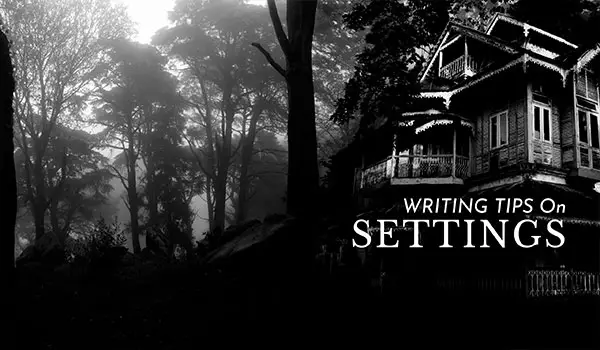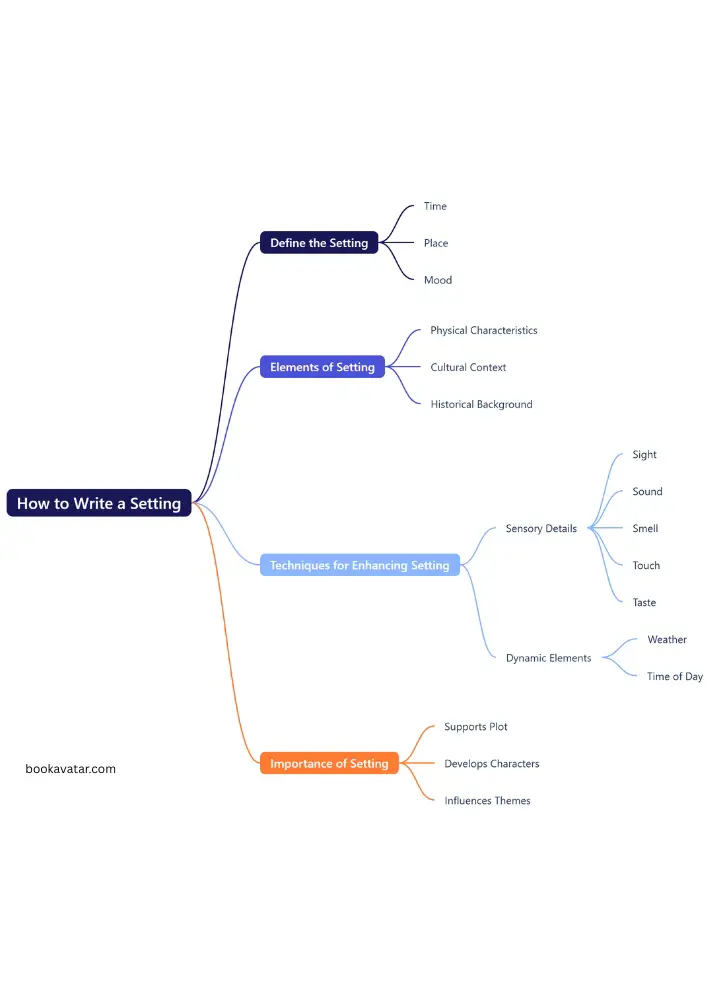
The setting is when and where a story or a scene takes place that you’re writing about. The readers have got to have a setting because they can’t paint a vivid picture in their minds if they don’t have the setting. For that picture to be painted, you must have many vivid details. If you have those details describing where the characters interact in your story, it will be clearer to your reader, and they will be able to experience what you hope.
Why do so many people ignore the setting? It could be because they must describe a place rather than dive into the story. Some writers love describing its setting a tad too much. That’s when you get nothing but world-building for 50 pages straight. Here’s the thing every story requires a setting, but it has to have a function, and a purpose, which means that having too much description of a setting could be better. So how do you write an effective setting for your story? Stay with me to know more in detail.
How to write a setting? (With Example)
When you describe the setting in your story, Ask yourself three questions: What’s the context? What’s essential to the protagonist or narrator, and what’s different for the reader? Let’s break down these three questions and use some examples to see what I mean. Also, here are 7 effective tips to writing setting for short and long stories.

1. Visualize the context
What’s the context? In other words, what is happening in this scene set in this setting? What are the characters going through? What is their mindset? What in this place you’re describing is most relevant to the scene’s action, and how would your characters view it? The details you choose to include and how you describe them might be relevant to the theme of your story. They might foreshadow things to come or hint at hidden meanings. Only some sentences of description that you write should do this because that would get tedious to read, but it’s something to keep in mind as you write.
For example, let’s look at a short passage from Beauty Queens by Libby Bray. In which the characters explore the small island that their plane has crash landed on, the Lost Girls set off down the beach. Taylor led the way. Adina Shanty, Petra, Mary Lou, and Tierra followed above them. The sun was a jaundiced eye to the right, and the vast turquoise ocean bit at the shoreline, gobbling small mouthfuls of sand.
The sand, white as desert-bleached animal bones, stretched for miles in one direction, yielding to jungle growth, and farther on, green mountains and lava formed cliffs, which created an almost turret-like wall running the length of the island. Behind those cliffs, a volcano rose, vanishing into heavy cloud cover. Its rumble could be heard on the beach like a giant groaning in its sleep.
This is how this narrator describes this island. If these characters were lounging on the beach with their drinks and they were on vacation, the narrator would have chosen very different words to describe what’s probably a wonderful island.
2. Prioritize the narrator
What’s essential to the narrator? The narrator is likely your protagonist unless you’re writing an omniscient POV. Either way, consider that you’re writing this scene through your narrator’s eyes. Imagine your narrator, your protagonist, standing in this setting with your reader. What do they want to draw your reader’s attention to, and what do they want to draw your reader’s attention away from? Unreliable narrators might focus heavily on something unimportant because they’re trying to distract the reader from the details that matter.
- So what does your narrator take note of, and what is important to them?
For this example, let’s look at the opening scene of Allegedly by Tiffany Jackson, a story about a young woman convicted of killing a baby when she was only nine years old. A fly got in the house on Monday. It’s Sunday, and he’s still around, bouncing from room to room like he’s the family pet. They don’t let convicted murderers have pets in the group home. He is not one of those noisy horseflies, so no one notices him until he zooms in front of your face and lands near your orange juice.
To the reader, this fits so well with a character in her situation, someone who, as the title says, Allegedly committed an unthinkable crime as a child. She wants to let the reader in later. All this gives us much insight into her as a character while also helping us visualize her group home setting in a few paragraphs.
3. Help readers to the imagination
What’s different for the reader? Whether you’re writing historical, contemporary, or fantasy, there will be elements of your setting that you don’t have to describe. It’s because your reader will automatically picture them, and you want to describe only some of the detail because that gets boring. Readers have great imaginations. They can fill in the blanks. You want to give them the details of your setting that stand out, the details that make this particular setting different from what the reader would expect.
Here’s an example from These Broken Stars, a sci-fi novel that starts at a party. Automatically when I say party, you can paint a picture in your mind. The difference is that this party is set on a luxury spaceliner Nothing about this room is real. The music would draw your eye to human musicians if this were a party at home. In the corner, candles and soft lamps would light the room, and the wooden tables would be made of actual trees. People would listen to each other instead of checking who was watching them. Even the air here smells filtered and fake.
4. Set a mood
Specific places create specific moods. In A Room with a View by E.M. Forster, We start in Italy in a romantic setting. In The Hunger Games, Katniss and her mother and sister live in Panem, a country that used to be North America. They reside in a poor mining district. Why are any of these settings important?
How else are you supposed to create a mood when it’s raining outside, and the sky is gloomy? We automatically feel sad and grumpy. So don’t matter what place you pick as your primary setting. What place can create the desired mood you’re going for in your story?
5. Select a time
Select a time of year based on the weather, holidays, and events. Is winter coming? That affects the story and the characters’ behaviors. Or we’re in the middle of a satanic holiday. In that case, that might affect your story. If that does happen, I hope you’re writing either a thriller or a horror. This isn’t a children’s book, folks. Maybe the time of year you choose coincides with a big festival that only happens once a year. It could be the annual festival of Saint Vladimir, the Vampire Saint, which would certainly move your story in one direction and affect the mood.
Also, remember that the time period you write in is a setting. Are we in the past, present, or future? We’re only floating dust particles in space. That’s enough existential crisis for the day. If you’re writing a dystopian novel, you must figure out how far the future you want to take your readers.
Prompt: If you’re going far in the past, what era are you choosing? Are we in Renaissance Italy? Are we living in the middle of the Civil war? We may be going back to 1341 B.C. to ancient Egypt. Where do you choose to take it?
6. Set location
Your characters affect their language, behavior, and thoughts. So choose accordingly and remember that your story could have multiple settings. You could switch between the present day and the early 1900s. You can take your characters to Greece and bring them back to America. Make sure that all locations have a purpose. Your characters aren’t traveling to Greece because you can imagine a plot. They’re traveling to Greece to uncover a family. Speaking of multiple locations, you can and should have various times of the day.
For example, your entire story only takes place in the span of a morning hour if you’re writing a short story or you have some twist. Your characters should generally move around a day, a week, or several months. Times change, and the best way to indicate the passing of time is to tell your reader what time of day or even what day of the week it is.
Prompt: Is our character jogging in the middle of the night that tells us that they can’t sleep and have something on their mind? Is our character at a bar at nine in the morning? What are they trying to forget? Time of day with location affects characters and stories, meaning, and mood. So choose it wisely and remember to consider your settings population. How many people live in your character’s town or city?
7. Show the culture
While considering your setting’s population, think about the setting’s culture. If your character is in New Orleans, there’d be a specific culture and famous food, and you’d hear many French words being tossed around. Many people would even have French last names.
As a result, the people’s behavior would be unique. Some cultures are quieter than others, while others love a good party. So choosing your setting based on its culture and people is as important as everything else.
Last Words
What matters when choosing your setting and writing an effective one for your story is that you have fun with it. Choose a setting that feels natural to the story you’re telling. We all feel a certain mood when we start writing our stories. So make sure your setting is aligned with the mood you carry inside your head.
Take a setting from the story you’re currently working on. Describe it in three sentences for the first focus on the context. How does your protagonist or narrator feel about this setting? What metaphor might they use to describe one part of the setting they’re looking at?
For the second, have your narrator draw your reader’s eye to one specific detail, whether it’s because they want the reader to notice it or because they’re drawing the reader’s attention away from something else. For the third sentence, describe one detail about this unexpected setting that is different from what the reader would expect.
What is the setting of your current or next book? As always, I would love to read whatever descriptions you come up with if you want to paste them down in the comments below. If you have questions about writing settings, let me know in the comments.
More writing tips:
How To Write A Theme For A Story?
7 Tips To Write A Main Character
3 Tips To Write A Good Antagonist
Table of Contents
